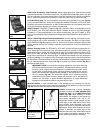
Terrestrial Observing
The ETX-60AT and ETX-70AT make excellent high-resolution, terrestrial (land) telescopes.
Viewing terrestrial objects requires looking along the Earth's surface through heat waves.
These heat waves often cause degradation of image quality. Low power eyepieces, like the
MA 25mm eyepiece, magnify these heat waves less than higher power eyepieces. Therefore,
low power eyepieces provide a steadier, higher quality image. If the image is fuzzy or ill-
defined, reduce to a lower power eyepiece, where the heat waves do not have such an effect
on image quality. Observing in early morning hours, before the ground has built up internal
heat, produces better viewing conditions than during late afternoon hours.
Astronomical Observing
Used as an astronomical instrument, your telescope has many optical and electromechanical
capabilities. It is in astronomical applications where the high level of optical performance is
readily visible. The range of observable astronomical objects is, with minor qualification, limit-
ed only by the observer’s motivation.
Sidereal Rate
As the Earth rotates beneath the night sky, the stars appear to move from East to West. The
speed at which the stars move is called the sidereal rate.
If the telescope is aligned, the motor drive is designed to rotate the telescope at the sidereal
rate so that it automatically tracks the stars. This tracking makes it easy to locate objects and
keep them centered in the telescope’s eyepiece.
Alignment (Mount)
The telescope's mount permits the movement of the telescope in both Altitude (vertically) and
Azimuth (horizontally). In order to automatically track a celestial object, the mount must be
properly aligned. Easy Two-Star Alt/Az Alignment is described on page 14.
Alt/Az Alignment
One-Star Alt/AZ Alignment or Two-Star Alt/AZ Alignment allows you to choose the alignment
stars during the alignment procedure. The stars are chosen from Autostar’s database of align-
ment stars. The database displays after One-Star Alt/Az or Two-Star Alt/Az Alignment is select-
ed. .
The term "Alt/Az." is frequently used to refer to the Altitude or horizontal and Azimuth or verti-
cal movements of the ETX-60AT and ETX-70AT telescopes. Other terms to describe a tele-
scope's movement may be used with telescopes that have mounts different from the ETX-60AT
and ETX-70AT.
Alt/Az Home Position
To set your telescope in the "Alt/Az" home position:
• Set the telescope on a flat level surface, such as a tabletop, or by mount it on the
optional #882 tripod
• Loosen the telescope’s vertical lock (
6, Fig. 1).
• Level the optical tube by lining up 0° on the Dec setting circle (17, Fig. 1) with the
pointer (
Fig. 13).
• Tighten the vertical lock (6, Fig. 1) to a "firm feel" only.
• Unlock the horizontal lock (9, Fig. 1) and turn the telescope horizontally until it points
North. Learn the position of Polaris, the North Star, which lies due North (Fig. 20).
A small pocket compass may be useful
• Re-lock the horizontal lock (9, Fig. 1).
• Press ENTER.
ADVANCED FEATURES
North
Declination
at 0˚
Pointer
Fig. 13: Alt/Az Home
Position.
Fig. 12: Tripod set in Alt/Az
Configuration on optional
#882 tripod.
Advanced Features 21


















